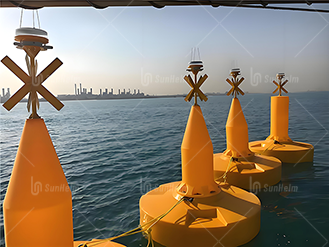Introduction: Why Marine Buoys Matter
Marine buoys play a big role in keeping ships safe at sea. They help ships stay on course, avoid shallow areas, and find safe water. You can think of them as floating road signs for boats. Each buoy has a special color, shape, and light signal that sends a clear message to sailors.
But marine buoys do more than help ships. They also help with weather monitoring, ocean research, and protecting marine life. In short, marine buoys are simple tools that do a lot. They are key to safe and smart operations on the water.
Overview: The Main Types of Marine Buoys
The International Association of Marine Aids to Navigation (IALA) classifies marine buoys into six main types:
- Lateral Buoys
- Cardinal Buoys
- Isolated Danger Buoys
- Safe Water Buoys
- Special Buoys
- Emergency Wreck Buoys
1. Lateral Marine Buoys
These buoys mark the edges of a safe channel. They show ships which side to pass on. In Region A, red means left and green means right. In Region B, it’s the opposite. Lateral buoys help guide ships safely through narrow waters.
2. Cardinal Marine Buoys
Cardinal buoys show the direction of safe water using compass points (north, east, south, west). They use black and yellow colors and different top marks. Flashing lights help sailors know where to go. These buoys are useful when a danger is nearby, and ships need clear directions.
3. Isolated Danger Buoys
These buoys mark a single danger, like a rock or sunken ship. They have black and red stripes and two black balls on top. Their lights flash twice. If you see one, steer clear—there’s a small hazard nearby.
4. Safe Water Buoys
These buoys show that all around is safe to sail. They are red and white with vertical stripes. The light often flashes in a pattern that tells sailors it’s a central, safe spot. Ships can pass on any side of this buoy.
5. Special Buoys
Special buoys mark areas like swimming zones, cable lines, or fishing areas. They are usually yellow and have an “X” on top. These don’t give navigation directions but show areas with special rules or activities.
6. Emergency Wreck Buoys
These are used to mark new dangers like recent shipwrecks. They are blue and yellow with flashing lights. They’re a temporary warning until a more permanent buoy is set up.
Other Types of Buoys
Besides the main types, there are other buoys for daily use:
- Mooring buoys for tying up boats
- Warning buoys for hazards
- Info buoys with messages or rules
- Dive and swim area buoys
Each has its own color and mark depending on its purpose.
How to Choose and Maintain Buoys
Choose buoys made from strong, weather-proof materials like UV-protected plastic. Use LED lights and check the buoys often. Make sure the lights work and the buoy stays in place. Good care means better safety on the water.
Conclusion
Marine buoys are simple but powerful tools. They guide ships, mark dangers, and support ocean work. By learning the six main types of marine buoys, you can understand how they keep waterways safe and organized. Whether you work in shipping, fishing, or marine research, knowing your buoys makes all the difference.


